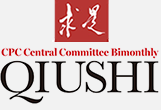Explorations to Forge a Distinctively Chinese Path to Opening Up
Over the 75 years since the PRC’s founding, and particularly since the launch of reform and opening up in 1978, China has consistently applied the principles of independence and mutual benefit. On this basis, it has carried out explorations to forge a distinctively Chinese path to opening up and actively participated in international economic cooperation and competition. All this has allowed it to achieve a historic transformation from a country that was largely isolated into one that is open to the outside world.
China has consolidated its position as the world’s largest trader of goods, making substantive progress toward becoming a strong trading nation
When the PRC was first founded, China’s industrial base was weak. Due to an economic blockade by Western countries, its international economic and trade exchanges were limited, with minimal trade in goods. Following the launch of the reform and opening up, and especially after its accession to the World Trade Organization, China quickly joined the wave of economic globalization. Foreign trade surged ahead, with the total volume of trade in goods in 2012 rising to 186 times the level for 1978. Since 2012, China has steadily consolidated its position as a major trading nation with a more proactive strategy of opening up.
From 2013 to 2023, annual growth of total goods imports and exports averaged 4.0%, outpacing global trade growth by 1.6 percentage points. China’s international market share rose from less than 1% in 1978 to 12.4% in 2023, while its global ranking for trade in services rose from 34th place to 4th place.
China has become a world leader in terms of the scale of two-way investment, and the attractiveness of the Chinese market has continued to increase
Over the past 75 years, China has steadily broadened market access for foreign investment, improved the business environment, and accelerated the pace of outbound investment. In 2023, China’s utilized foreign direct investment reached USD$163.3 billion, a 176-fold increase over 1983; non-financial outbound direct investment reached US$130.1 billion, 61 times higher than in 2003. Since 2012, the quality of two-way investment has further improved. In 2023, high-tech industries attracted 37.3% of total foreign investment, while non-financial direct investment under the Belt and Road Initiative accounted for nearly one-quarter of all such investment.
International economic cooperation and trade have been steadily deepened, with significant progress in opening up at the institutional level
Since 2012, China has accelerated the development of new institutions for a higher-standard open economy, effectively expanding the space for international economic and trade cooperation. In 2023, China’s 22 pilot free trade zones accounted for 18.4% of the total import and export volume. The Hainan Free Trade Port, meanwhile, has maintained double-digit import and export growth for three consecutive years.
China has signed more than 230 Belt and Road cooperation documents with more than 150 countries and over 30 international organizations. The CR Express now serves more than 200 cities in 25 European countries. In addition, major exhibitions, such as the Canton Fair, the China International Import Expo, and the China International Fair for Trade in Services, have steadily grown into important platforms for deepening international cooperation.
Editor: Yi Xiaowei
(Excerpts from “Opening a New Chapter After 75 Years of Development” by the CPC Leadership Group of the National Bureau of Statistics, Qiushi Journal, English edition, No. 6, 2024)
























